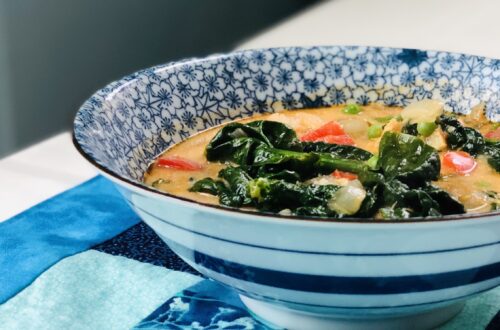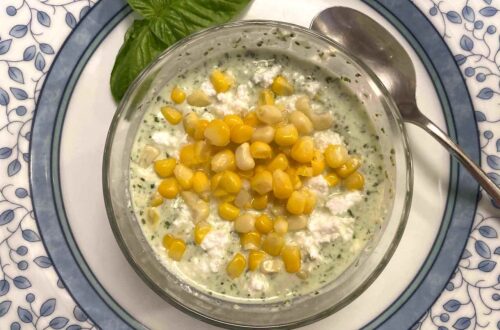Recipe
-
Eggplant with Minty Tomato Sauce and Yogurt
The first year I lived in Berlin, my roommate and I cooked a lot. That year I learned to roast a chicken, not be scared of baking things I’d never heard of, and to put a lot of salt into pasta water. This dish – eggplant with minty tomato sauce and yogurt – was one of our staples, something we’d often make after coming home from a long day or for friends on the weekend. I’m not sure why, but I stopped making it for a number of years. When I decided to cook it this summer, I had no idea where I had gotten the recipe from. A quick google search showed me it is one of Madhur Jaffrey’s recipes, which explains why it’s so good. I’ve always loved eggplant, and the combination of spice and cumin cut by the creamy yogurt is a great late summer dish.
There is a lot to say about eggplants, olive oil, and tomatoes, but today’s post focuses on spices, specifically cumin. Cumin is the second most popular spice in the world, just behind pepper. Historians believe that it was first grown in Egypt, along the Nile, where it was used in the mummification process. The Greeks and Romans also used cumin, although they associated the spice with greed. Cumin didn’t remain in the Mediterranean, but spread around the world. It traveled east to Persia and then to India, as well as west to Spain and from there to North and South America. This spread of cumin explains why it is found in so many different food cultures: Indian, Iranian, Middle Eastern, Mediterranean, Mexican, Cuban, and many more.
-
Blueberry-Peach Pie
When I was a child, vacation meant pie. Key lime pie, strawberry rhubarb pie, but most importantly, blueberry peach pie. In my memory, this was the perfect pie: not too sweet, just tart enough, with a flaky crust. We would pick it up from a pie stand on the side of the road and I would hold it carefully on my lap on the ride home, feeling the heat from the freshly baked pie through the container. That pie stand disappeared some years ago, but since then I’ve been trying to recreate this perfect pie. I’ve spent years trying out different crusts – all butter, with vodka, butter and shortening – but just one tablespoon of apple cider vinegar here makes all the difference. The filling is sweet but still a little tart, with no cornstarch and no frozen berries: just the best pie dough I can imagine with that perfect mix of blueberries and peaches.
Blueberries are the focus today, since here in the Midwest we are at the height of blueberry season. The US is the world’s largest producer of blueberries, producing an estimated 690 million pounds in 2016. Despite the large domestic production, the US is actually a net importer of blueberries, due to the large imports during the winter months when they don’t grow in the US. In 2017, the US imported 137.8 million pounds of fresh blueberries, over half of which came from Chile.
-
Saag Feta
The pandemic has given me a chance to explore some new cookbooks. There are a few that I’m really excited about, but right now I’m obsessed with Indian(-ish) by Priya Krishna. It’s a collection of “Indian-ish” recipes – think Indian with American influences – that Priya’s mother cooked while Priya was growing up in Dallas. The recipes are simple but tasty, the photos are beautiful, and it has even inspired others in my apartment to try out the recipes. Although I want to cook just about everything in the cookbook, there is one recipe that I have fallen in love with: saag feta. Priya (really, her mother), replaced the paneer with feta and the end result is delicious. The feta melts perfectly into the spinach, adding a saltiness that matches the spice and the spinach.
I could go on and on about the saag, but I’ll get to the point. I’m cheating this week. Instead of an ingredient in the dish, I’m going to discuss an ingredient that goes with (or under) the dish: rice. I recently learned that almost 85 percent of rice consumed in the US is grown domestically and was astounded. Sure, I knew that the US had once grown rice – although the US history I had learned in high school and college was woefully inadequate, I knew that enslaved people had been forced to work the rice paddies in the Carolinas, which was incredibly dangerous and deadly work, where malaria, yellow fever, and other dangers were ever-present. (Also, it was actually enslaved people’s expertise in rice cultivation, brought over from Africa, that made rice growing in the US possible.)
-
Challah
In mid-April, around the period of this-stay-in-place-thing-has-already-gone-on-forever-how-much-longer-will-it-last (a lot longer, it turns out), I decided that I needed a way to make different days feel, well, different. Based not on religious practice but on a desire for a ritual to regulate the week, I started to make challah every Friday. For a few short weeks (three weeks, to be exact), while winter still hovered over Chicago, it was a great way to welcome in the weekend.
Over the years I’ve tried a few challah recipes, and this one is easily my favorite. (Hot tip: for anyone in a place where good hamburger rolls are difficult to find, you can make great rolls out of challah dough.) This recipe comes from Tori Avey, whose blog is my go-to for all Jewish foods. When I first made this challah, we discussed making French toast out of it. That never happened, since the challah never lasted long enough to get stale. (Or until Sunday, the day of Big Breakfasts.)
-
Turkey Meatballs
When I started this blog, I promised myself that I wouldn’t rely on too many of Deb Perelman’s recipes from Smitten Kitchen. But here’s the problem: because her recipes are perfect, for years they’ve been the core of my cooking. Whenever I needed a recipe – for dinner, a picnic, or a party – I’d turn to Smitten Kitchen, and Deb always delivered. These meatballs are no exception. They are a simple, do-ahead, hearty meal that became a staple for me during law school. Delicious over pasta, they are just as good on their own – and even better with garlic bread.
The original recipe calls for ground beef and pork, but I like to use ground turkey. I’m sure the beef/pork mix is delicious, but I’m not a huge fan of ground pork and it’s never tasted quite as good with beef as with turkey. So I stand by my choice of ground turkey – with a caveat. These meatballs are good when you first make them, but to truly enjoy them as they‘re meant to be enjoyed, make them a day ahead of time. The flavors mix overnight in a way that is magical.
-
Gazpacho
Gazpacho is one of the true joys of summer, along with picnics in the park and reading on the beach. As July begins and real summer hits Chicago – hot and humid, and miraculously, this year perfectly sunny – it’s time for gazpacho. For years my mother made this recipe and I always loved it. When I finally asked her for it, I realized just how simple it is. You chop up some vegetables and mix them together with liquid, and then wait for the soup to get cold. That’s it. But despite its simplicity, there’s something special about it – especially when you add the crunch of the croutons to it.
I’ll stop raving about the gazpacho and get to the main ingredient: tomatoes. I know that I’ve already written about tomatoes and that there are a lot of ingredients I haven’t yet discussed. But it’s the middle of summer and a great time for socially distanced picnics, so I want everyone to be able to enjoy this recipe. For this post, I focus on tomatoes from Italy, which is a large producer of processed tomatoes. In 2018 Italy exported 1.74 billion Euros worth of processed tomatoes – 53 percent canned tomatoes, 35 percent tomato paste, and the remaining 12 percent of tomato sauce.
-
Roasted Asparagus with Pickled Lemon and Feta
I love asparagus. Green asparagus, white asparagus, even purple asparagus. I could easily eat it every week and never tire of it. I love it with my mother’s hollandaise sauce and with this easy buttery caper sauce. But my favorite way to eat it right now is with this pickled lemon and feta, a simple recipe from the Chicago restaurant Avec. It’s lemony, a little bit spicy and salty, but still allows the asparagus to come through.
Growing up in Chicago, I always knew that Michigan grew a lot of asparagus, but I didn’t realize just how much. Michigan is currently the largest producer in the US, producing as much as 23 million pounds each year. Being this close to Michigan means that our local grocery store and every farmer’s market sells fresh, Michigan asparagus – even though most of the asparagus sold in the US these days is actually imported from Peru and Mexico. (Between 2004 and 2014, the amount of asparagus grown in the US decreased dramatically – by one estimate, by 64 percent – in large part due to these cheaper imports.)
The asparagus season is winding down, but before it ends completely I wanted to grab this moment to talk about labor conditions in the asparagus industry. Although I just spent the past couple of months enjoying my local Michigan asparagus, I actually want to focus on asparagus grown in Germany, where eating white asparagus in the spring is a national pastime. I had never eaten white asparagus until I moved to Germany. But in Germany, every year in late spring, restaurants starts to list asparagus – Spargel – as the special. Markets and grocery stores sell it, and everyone gets really excited about Spargelzeit (asparagus time). I never learned to cook the white kind, but my wonderful roommate would cook it with prosciutto and potatoes – and it was always delicious!
-
Strawberry Cake
Every summer in Berlin, little huts from Karls Erdbeerhof (Karl’s Strawberry Farm) pop up outside of train stations and sell strawberries by the kilogram. This is my favorite time of year in Germany, where I lived for five years: the days are long, everyone is outside, and the world feels at peace. Plus, there are strawberries – and lots of them. When I first moved to Germany, these luscious and sweet strawberries were a revelation, so different from the perfectly shaped, watery-tasting ones I had grown up eating.
This cake is all about strawberries and, to me, it tastes like summer. It tastes like a picnic at Tempelhof, the former airport turned public park in Berlin, where crowds gather as soon as the weather permits. It tastes like the joy of sitting on the grass for hours, eating and drinking as the sun sets and friends come and go. It tastes like the carefree feeling of summer in Berlin.
As you could probably have guessed, picking strawberries is neither easy nor carefree. It’s difficult work that involves stooping down and squatting for hours at a time. Workers must move quickly and know which berries are ready to be picked, while also being gentle with the berries to avoid bruising them. Pesticides are also a major problem. According to the Environmental Working Group, strawberries are “the fresh produce item most likely to be contaminated with pesticide residues.” This is true even if the strawberries are both rinsed in the field and washed before being eaten. 98 percent of strawberries tested by the federal government had pesticide residue on them. While there is limited data on these pesticides’ effects on workers, there is evidence that pesticides and fumigants can lead to increased risk for cancer, harm child development, and may cause birth defects.
-
Mediterranean Fish Stew
At some point during my childhood, fish stew became the dish that my father and I cooked together. This was always an extensive process: we’d buy or make fish stock, which was either bland or way too fishy; we’d cook bacon, chop up all the vegetables, add everything to the pot; and then we’d step back and wait. We’d taste it, realize it was all wrong (often too fishy), and separate the whole thing out into two pots and more or less start over. Somehow it always ended up tasting good in the end, although I still don’t understand how.
More recently, we’ve cooked various Mediterranean-style fish stews. This recipe is the most recent and, in my view, by far the best. I’ve simplified the original recipe so it can be made with household spices, added raisins to contrast with the saltiness from the anchovies, and chosen to use chicken stock instead of water, which some may see as sacrilegious. I don’t care; it’s my kind of fish stew. (I’ve also added shrimp, because what’s a fish stew without shrimp.)
Cod is the center of this stew. A bottom-dwelling fish, cod was once everywhere in the Atlantic; it’s said that you used to be able to walk across the ocean on the backs of cod. But after centuries of fishing, by the 1990s the stock on the North American side of the Atlantic had been drastically reduced – off Canada down to 1 percent of its former level, while on the US side down to around 3 or 4 percent.
-
Avocado and Pea Dip
Two summers ago, I was living in Chicago for a couple of months when a friend came to visit. Through some hard-core restaurant searching, we ended up going to Ema, a California-inspired Middle-Eastern restaurant, for brunch. It was great – everything tasted fresh and it was the perfect combination of doughy breakfast foods and light hummus and labneh served with fresh pita. (Not sure how this turned into a restaurant review, but here we are – if you’re in Chicago, the brunch is worth it.)
This recipe comes from Ema. I have to admit that the first time I made it I was disappointed. Although the recipe I found online calls for 4 teaspoons of salt (which has to be an error), I added only one – and even with that reduction I thought it was so salty it was on the verge of being inedible. However, the next day I tried it again and it miraculously tasted great. Here’s a slightly revised version, to be eaten with vegetables or on toast.




























